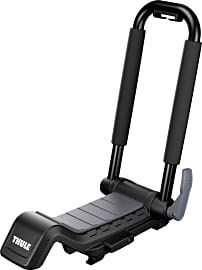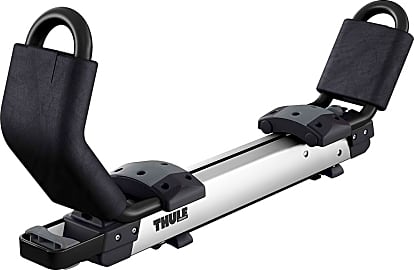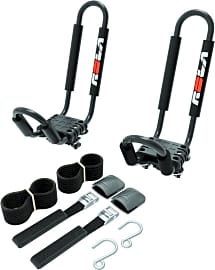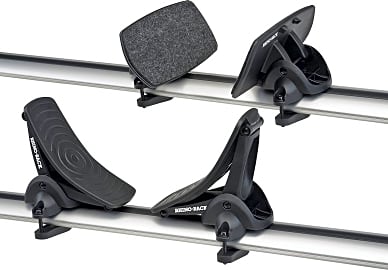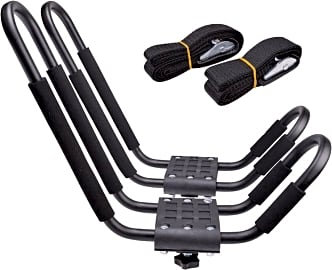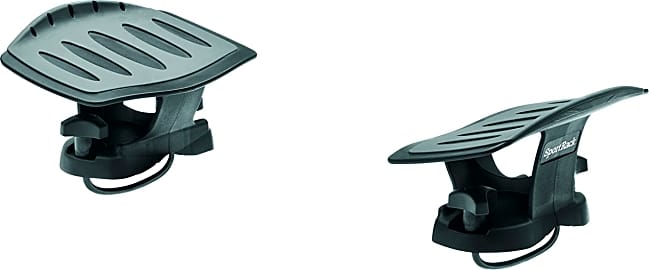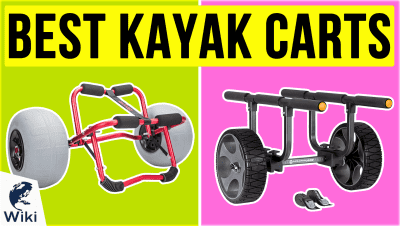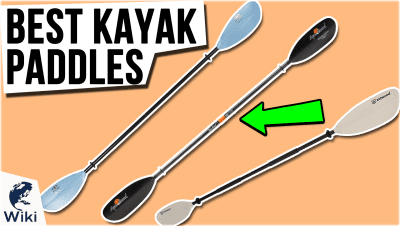The 8 Best Kayak Roof Racks

This wiki has been updated 40 times since it was first published in October of 2016. Get your kayak to the water easily and safely by mounting it on top of your ride using one of these sturdy roof racks. Designed to safeguard both your craft and your car during transit, they are available in models that will work with most vehicles. As a rule, you should always carefully follow any manufacturer's instructions regarding setup and use to avoid any damage or accidents. When users buy our independently chosen editorial selections, we may earn commissions to help fund the Wiki.
Editor's Notes
October 19, 2020:
In today’s update, we added in the Thule Hull-a-Port XT, which can be used to carry one kayak in its J-cradle design, and two when you convert it to its boat-stacker position. Its proprietary system ensures easy strap management when you’re loading it, and it folds flat neatly when not in use. It comes fully assembled out of the box, for a quick and easy setup. Included are load straps with buckle bumpers, as well as stern tie downs for one boat. It locks securely to the load bars when you purchase and install the manufacturer’s One Key System. It joins another model from the same manufacturer, the Thule Hullavator Pro, which is great for anyone who prefers to load and retrieve their boat at waist level. Incorporated are secure tie-downs for your bow and stern, as well as eight touch-points of padded support. This one is good for accommodating wide hulls, and you can rest assured it’s highly resistant to rust.
The Yakima Jaylow retains a prominent spot on our list, and its simple design allows for quick, tool-free installation. For better aerodynamics and ample garage clearance, it conveniently folds down compactly. Speaking of compact choices, the Rhino-Rack Nautic 570 consists of low-profile front and rear pads designed to accommodate a variety of hull shapes, and they rotate 180 degrees for easy loading of your kayak from the side. The SportRack Jetty Saddle comes with four saddles designed to hold your boat in a flat position, rather than upright, to help reduce wind resistance and put less pressure on the frame. They’re equipped with protective rubber padding and non-skid surfaces, but make sure they’re compatible with your hull size in advance, as they might not accommodate larger ones.
July 07, 2019:
Joining the list in this update is the sturdy Thule Hullavator Pro, which is quite an investment but will make loading and unloading your kayak much easier on your back. This is thanks to its gas struts and arms that conveniently fold down to its sides. It features the manufacturer’s QuickDraw bow and stern tie-downs as well as two, 2x9-foot straps that offer car-protective buckle bumpers. It’ll accommodate hulls of up to 36 inches in width, and features a corrosion-resistant base and cradles. Thule also makes a set of cylinders, which are sold separately that allow you to lock the rack securely to your vehicle.
Retaining its top spot is the Yakima Jaylow, a fuss-free selection that installs in no time and can also be folded down conveniently when you don’t need it. Its soft, molded base is designed with grooves to help cushion your boat and allow sand and grit to wash away easily. Another collapsible choice is the highly rated Malone Downloader Folding J-Style, which cushions your craft nicely to ward off scratches even on the bumpiest of rides.
With any kayak roof rack, be sure to install it correctly and attach your boat securely, to keep your craft safe during transportation – and more importantly, to ensure your personal safety and that of any drivers around you. Kayaking enthusiasts recommend allowing plenty of time to load your craft onto the rack, to ensure the tie-downs and bow and stern lines are secured properly. As a rule, periodically check your lines while traveling, such as whenever you stop to fill up your gas tank. While doing so, gently push your craft to see if it moves easily; if it does, figure out what area needs tightening. Always bring extra tie-downs with you, in case they’re needed during your trip.
Saddles, Cradles, and Stackers, Oh My
You can go with horizontal saddles and rollers, stackers that are designed in a vertical fashion, or J-cradles as a nice side-loading option.
Make no mistake, kayaking is far from easy. Still, for an avid kayaker, the breeze on your face as you surge across the open water makes all of the hard work it took to get to that point completely worth the effort. And for many, that effort includes transporting your kayak a substantial distance before slipping it into the current.
Unless you live on a sprawling river or lake — or in very close proximity to one — a kayak roof rack is an indispensable piece of equipment. A number of elements will determine the style of rack you choose, such as the type, size, and the number of kayaks you’ll be transporting. The vehicle you plan to use — including its roof crossbar setup (or lack thereof) — will significantly influence your decision, as well.
Before you analyze those factors, it’s a good idea to familiarize yourself with the styles of racks available. You can go with horizontal saddles and rollers, stackers that are designed in a vertical fashion, or J-cradles as a nice side-loading option.
Saddles, which consist of two pads that spread from the vehicle’s base rack to the bottom of the kayak, utilize as much of the roof’s flat surface as possible to provide stability. These are aerodynamic, easy to load and unload, and available in fixed or adjustable designs.
If you’re looking for even more convenience, rollers allow you to slide the bow onto your vehicle first, then lift and roll the stern onto the saddle you have in place. While these do simplify the loading and unloading process, there is a drawback: if you run into rough weather or heavy winds, you’ll likely experience some shuffling and sliding of your watercraft while you’re on the move.
Compared to the other styles, stackers utilize about half the crossbar space, which increases your loading capacity. By stacking them, you can usually fit up to four kayaks on the roof of a relatively large vehicle. They’re typically affordable and easy to install, but you may need to purchase additional support (such as crossbar pads) to prevent slippage.
As it’s the world’s most popular style, you’ve probably seen a J-cradle during a road trip at some point in your life. J-cradles sit at a 45-degree angle on your crossbars, which helps free up extra space on narrow roofs for another kayak or extra gear. Because you load it manually on the side of your car, this model isn’t ideal for two-person kayaks or people who lack the size and strength to lift the watercraft on their own.
Zeroing In On The Ideal Rack
Just as the act of kayaking is not easy, choosing the right roof rack can be a laborious process. Assuming you have already identified the vehicle onto which you will be installing the rack, you’ll want to assess its current roof setup as a first step.
A bare or naked roof — one that does not feature a factory rack, rails, or crossbars — is probably the least desirable option. You can use a door jamb clip as the point of attachment, but this is not reliably secure. If you find yourself in this situation, your best bet is to invest in upgrading your roof with rails or crossbars.
Assuming you have already identified the vehicle onto which you will be installing the rack, you’ll want to assess its current roof setup as a first step.
Factory rails that run parallel with the roof of the car provide a solid base. They’ll support a substantial amount of weight and multiple kayaks, but the load capacity will ultimately depend on your car manufacturer. Factory crossbars can perform admirably as well, but they won’t support quite as much weight.
Once you’ve determined the type of roof you’re working with, ask yourself a few critical questions. How often do you plan to go kayaking? How many kayaks will you need to transport regularly? Will you be taking any long-distance trips?
If you’re a frequent kayaker — weekly or even daily — you’ll probably want to spend the least amount of time possible loading and unloading. To maximize convenience, think about narrowing it down to saddles, rollers, and stackers.
The number of kayaks you intend to travel with is an important factor, as well. For those of you planning on hitting the water with the whole family or a sizable group of friends, the stacker is the optimal model. If you only have two kayaks and a car with a narrow roof, the J-cradle will suit you best. Depending on the size of the watercraft and the car, solo kayakers may want to consider the saddle style.
Don’t forget to consider the rack’s additional features and accessories. The durability of the material that makes up the rack becomes more important if you live in an area with harsh weather. Some models collapse or fold up, which makes them easier to store when you’re not using them. If you have to transport the rack on foot once you’ve gone as far as you can on wheels, think about investing in a quality kayak cart.
Ditch The Motorboat, Embrace The Kayak
There’s no shortage of passionate boaters spanning the globe today, and for good reason: boating is a blast. But while boating scores high in entertainment points, its benefits simply don’t stack up to those of the kayak in a variety of areas.
There’s no shortage of passionate boaters spanning the globe today, and for good reason: boating is a blast.
With a motorboat, you can hit high speeds, but can you build strength, burn calories, and enhance your cardiovascular fitness at the same time? Kayaking serves as a challenging full-body workout, which helps increase endurance, improve heart health, burn fat, and strengthen muscles across the body.
Studies have also shown that kayaking releases chemicals in the brain that enhance your mood and help fight depression, which means you can add improved mental health to the long list of physical benefits associated with the activity.
I’m sure some fishermen out there are rolling their eyes right now; we can talk about health advantages until the cows come home, bit if you’re not catching fish, what’s the point, right? Before you move on to browsing aluminum fishing boats, take a look at some fishing kayaks, which are designed specifically for anglers like yourself.


